“Chemical cocktails” are polluting England’s rivers, lakes and groundwater sites and poisoning wildlife, analysis has revealed. They were found in 1,600 waterways including the River Irwell which stretches 39 miles long from the headwaters in Rossendale to its canalised lower reaches in Salford.
This week as late spring turns into early summer nature appeared to be thriving where The Irwell meets the River Roche in Springwater Park, Whitefield. Sand martins were flitting out of riverbank nests; grey wagtails bobbed between rocks in the shallows, and four goslings trailed their Canada geese parents. The water is also clear enough to see two huge lorry tryes on the river bed.
But the Irwell at the footbridge over Salford University was among the top ten sites in the country for having the highest number of chemicals. It shared 8th position with the Mersey at Flixton Road in Trafford where 91 chemicals were identified from samples taken. The worst was also in the north west - 101 chemicals in the Mersey above Howley Weir in Warrington.
Around 100 chemicals, including PFAS "forever chemicals", pesticides and pharmaceuticals, have been found along the Irwell, Mersey, Stour, Colne, Thames, Trent, Yare, Medway, Humber and Avon rivers, though the actual number of pollutants is likely to be much higher, researchers said.
Using Environment Agency (EA) data, Wildlife and Countryside Link (WCL) and The Rivers Trust found toxic combinations proven to be harmful to wildlife in 814 river and lake sites – 81% of the total where data is available. They found the same cocktails in 805 groundwater sites, representing 74% of the total.
Researchers tested for five different hazardous mixtures involving the forever chemicals PFOS, PFOA, PFBS and PFHxS, the pesticide 2,4-D and the painkiller ibuprofen. More than half of all the 1,619 sites studied contained three or more of the five toxic mixtures.

These chemicals, which enter the environment through industrial and agricultural pollution or sewage, combine to create increased poisonous effects on species such as amphibians, fish, insects, nitrogen-fixing bacteria and algae. Detrimental effects include reduced growth and cell function, impacts on embryos and lower survival rates.
Any potential effect on humans, whether through bathing, drinking or recreation, is unknown.
In the North West one or more of the 5 chemical cocktails searched for were found in 239 river, lake and groundwater sites tested for chemicals by the EnvironmentAgency. This includes 106 river and lake sites (out of 152 sites – 70%) and 133 groundwater sites (out of 188 sites – 71%)
Of the sites where the chemical cocktails were detected 154 sites (out of 239– 64%) had 3 or more of the 5 chemical cocktails present. Rivers where 3 or more of the chemical cocktails were found include: the Weaver, Mersey, Irwell, Wyre, Lune, Leven, Wampool, Ribble, Derwent andEden.
Up to 101 individual chemicals were found in some rivers in the region, though actual numbers could be much higher due to the Environment Agency only testing for a limited number of chemicals. Rivers in the region with the highest number of individual chemicals detected include: the Mersey, Irwell, Ribble, Weaver, Wampool, Douglas and Wyre.

Last year a parliamentary report concluded that raw sewage, microplastics, and slurry are coursing through all of England's rivers jeapordising health ands nature. Agriculture and water companies are the biggest contributors to this "chemical cocktail", the Environmental Audit Committee warned. Car tyre particles, oils and wet wipes are also clogging waterways.
Richard Benwell, chief executive of WCL, said: “A harmful chemical cocktail is being stirred up in UK rivers, putting wildlife and public health at risk.
“Government regulates and monitors chemicals individually, ignoring the cocktail effect. But our research shows that toxic combinations of pesticides, pharmaceuticals and forever chemicals are polluting rivers up and down the country.
“The new chemicals strategy must make sure harmful substances are regulated not just for individual risks, but for their effects in combination.”
The combinations include: PFOS and PFOA, which have been shown to damage amphibians’ cell activity; PFOS and 2,4-D, which is toxic to nitrogen-fixing bacteria; PFOS and PFBS, which damages algal photosynthesis and slows its growth; ibuprofen and PFOA, which damages the growth of the microalga called P. subcapitata; and PFOS and PFHxS, which reduces the survival of midges.
The researchers said these combinations were studied in a controlled laboratory and that they may mix with other chemicals in the natural environment in other unknown ways.
PFAS is the collective name for the group of nearly 10,000 industrial and household substances including PFOS and PFOA. They are nicknamed forever chemicals because of their failure to break down in the environment.
PFOS and PFOA are the only two of the family that are restricted in the UK after they were linked to a series of severe health issues.
WCL and The Rivers Trust, as well as The Wildlife Trusts, Surfers Against Sewage, The National Trust and other environmental and conservation groups, are backing a campaign to phase out toxic chemicals such as PFAS from all but the most necessary uses.
They want chemicals regulated in groups, so if one chemical is found to be harmful then others with a similar molecular structure would face similar restrictions.
And they want to see more research into chemical cocktail impacts on wildlife and human health, with assessments on how substances interact before they are allowed on the market, as well as a more rigorous environmental monitoring programme with more funding for the EA.
Ruth Jones, shadow minister for environment, food and rural affairs, said: “The UK’s current approach on chemical pollution is failing, and these stark statistics are yet more evidence of this.
“No-one wants to swim in a lake polluted with pesticide, have hidden forever chemicals in our drinking water, or see otters, fish, dragonflies and other wildlife poisoned by toxic chemicals in our waters.
“We need action now to curb the chemical cocktail in our rivers, but it is slow to arrive and disappointing when delivered, such as recent limited proposals on PFAS regulation.
“The Government must up its game and tackle the sewage pollution scandal and chemical pollution crisis together to give communities and nature the clean water they deserve.”
A Government spokesperson said: “We are working closely with our regulators to assess the potential risks posed by unintentional chemical mixtures to our environment.
“This builds on work since the 2000s to increase monitoring and either ban or highly restrict a number of PFAS, both domestically and internationally.
“We will set out our approach to managing chemical mixtures in the chemicals strategy later this year.”
Despite concern over the chemical content the Irwell's health has improved. Its prospects seemed bleak when, in 1926 the author Arthur Ransome wrote in the Manchester Guardian: “I am continually asked by correspondents where they may find good trout fishing within reasonable distance of Manchester. I wish I knew.
"Perhaps our grandchildren may catch trout and salmon in the Irwell. Nothing is wrong with it but the unmitigated filth of man…Something may some day be done to restore dead, murdered rivers like the Irwell to the life that man has taken from them…The river will cease to be a sewer, and the day will come when men stop in crossing a bridge in Manchester to see the trout feeding below it.”
The grim image of the river which was also highlighted in a 1950 House of Commons debate. The then MP for Rossendale, Anthony Greenwood, chose to refer to another Manchester Guardian description of the river as a "melancholy stream".
Quoting a contemporary report by the British Field Sport Society Mr Greenwood told Parliament the banks of the Irwell and its tributary, The Roch, were "lined with factories, large and small, many of which take their water from the drainage of the hills forming the slopes of the river's valley, and discharge it as a polluted effluent, either into the small feeders, or the main river itself, so it may be said that no natural water normally enters the river from its cradle in the moors to its grave in the Manchester Ship Canal."







